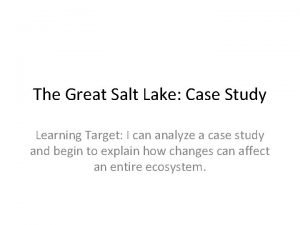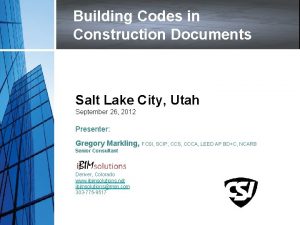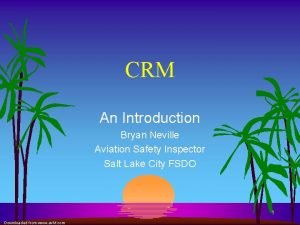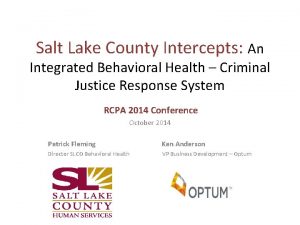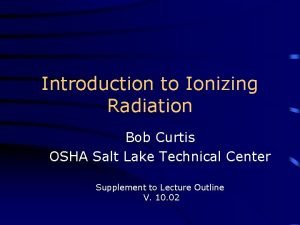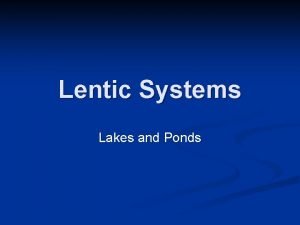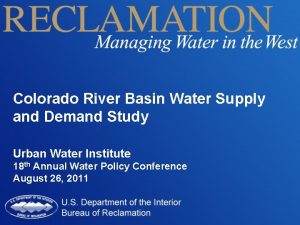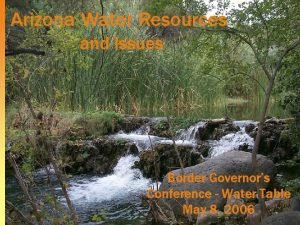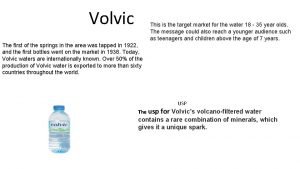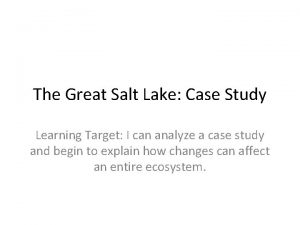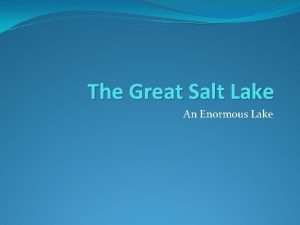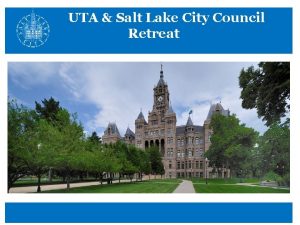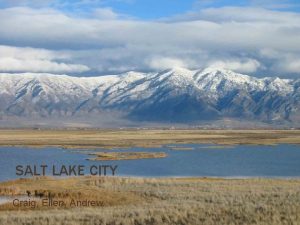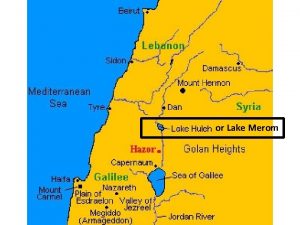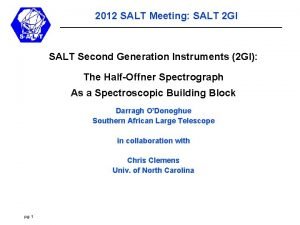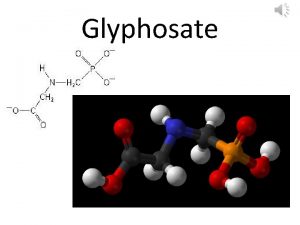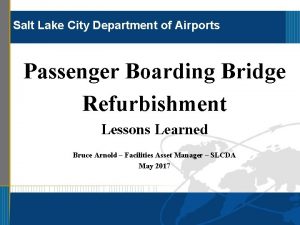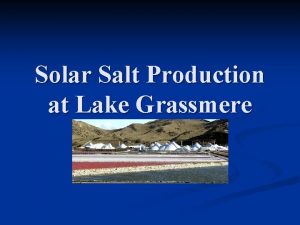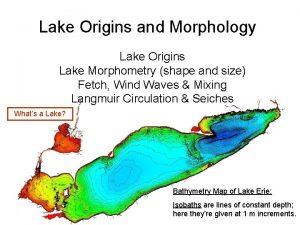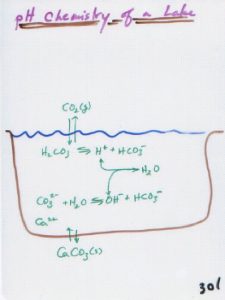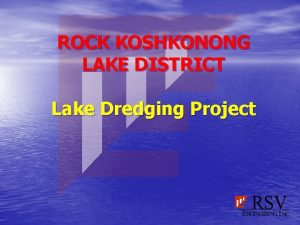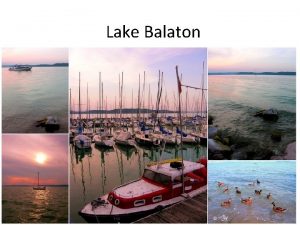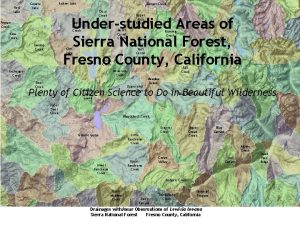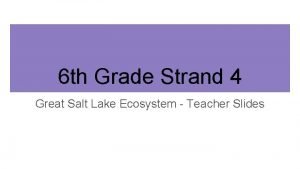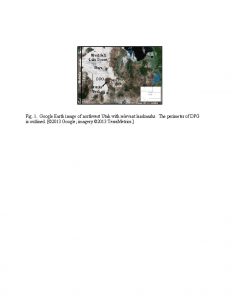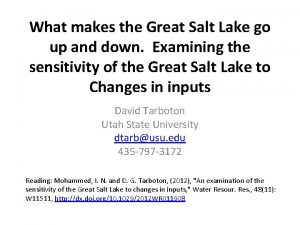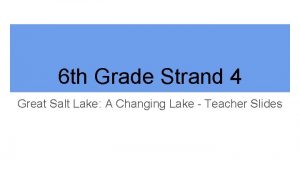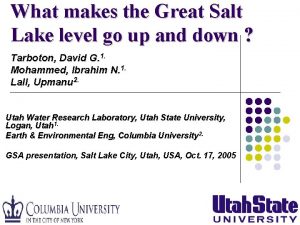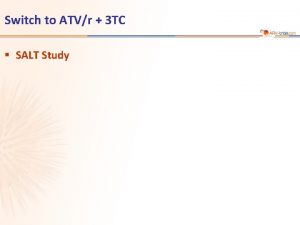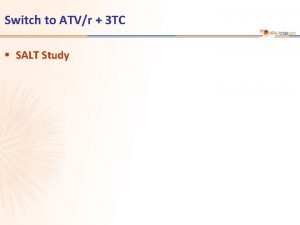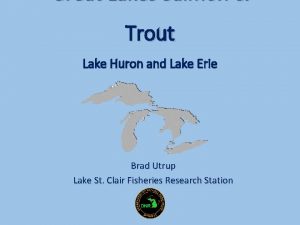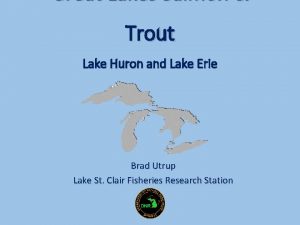The Great Salt Lake Case Study Learning Target

























- Slides: 25

The Great Salt Lake: Case Study Learning Target: I can analyze a case study and begin to explain how changes can affect an entire ecosystem.

Warm Up 1. Why is the Great Salt Lake salty? 2. What factors affect the salinity of the Great Salt Lake? 3. How would and increase in salinity affect the biodiversity of organisms living in the aquatic portion of the Great Salt Lake?

Great Salt Lake - Case Study Details What is a causeway? Let’s look at the next slide to find out. • Setting: A large body of water • Time: 1952 • Event: A causeway is built across the body of water separating the north end from the south end. No water is exchanged between the two sides. • The general question: What effect does this have on the ecosystem?

The Specifics • In 1902, a railroad built a train trestle that went directly across the body of water. In the 1950’s, a causeway replaced the trestle allowing for safer and faster travel of the trains. • The causeway is a solid, raised roadway made of 50 million cubic yards of rock, sand gravel. However, unlike the trestle, the causeway does not allow circulation of water between the two sides. This basically split the lake into two halves, the North arm and the South arm. Use the information from this slide to answer questions 1 & 2.

Turn & Talk: What do you see in this picture? South Arm of Lake North Arm of Lake White stuff

The causeway separating the North and South arms South Arm of Lake What do you notice about the colors of water on both sides of the causeway? Question #3 North Arm of Lake

This body of water is a dynamic ecosystem and is affected by the amount of rainfall received How does the size compare 1984 in 1984 and 2004? Question #4 What inference could you make about the amount of rainfall received in 2004? Question #5

Brainstorming • What differences do you notice, if any, between the north and the south arms? • Why could building a causeway cause the water to be two different colors? – What might be some causes of the change seen? As ac pos lass , s clas ibilitie creat e sm ate s. Wri a list s’ id te d of o eas. Q wn yo ues tion ur #6

New Information • Both arms of the lake contain salt. • Only one arm of this body of water receives freshwater on a continuous basis. – 2 rivers flow into that arm. – Does this help you explain why the body of water is two different colors? • Answer questions 7 and 8 Turn & Talk: What is freshwater?

These are red onion cells. The purple stuff is the cytoplasm inside the cell.

After adding salt, look what happens. What is happening to the amount of purple cytoplasm inside the cell?

After adding EVEN MORE salt, look what happens. What is happening to the amount of purple cytoplasm inside the cell? In osmosis: water follows salt! - Wherever there is more salt, water will go because it loves salt! What do you think is causing that to happen?

#9: What inference can you make about which plant received salt water? Why?

The causeway separating the North and South arms South Arm of Lake North Arm of Lake

A Lake Divided: Salinity Before and After the Causeway 300 240 210 180 150 120 90 60 30 0 http: //ut. water. usgs. gov/greatsaltlake/salinity/index. html SALINITY, IN PPT ? 270

Water Level History of the South Arm of the Great Salt Lake http: //geology. utah. gov/online_html/pi/pi-39/pi 39 pg 04. htm

Historic low GSL level Historic high GSL level http: //ut. water. usgs. gov/greatsaltlake/salinity/index. html

http: //geology. utah. gov/online/pdf/pi-51. pdf Lake Level and Water Density Inversely Correlate • Which arm of the Great Salt Lake is saltier? Evidence? • How does lake level influence density?

Digging in to the GSL Salinity Data • Salt concentration can be measured in: – Percent Salinity – Parts Per Thousand (= % x 10) • Salt concentration can be inferred as: – Density of Water • Density of water = 1 gram / cm 3 = 1 g / m. L • If density is greater than 1 g/m. L, there is something dissolved in the water (i. e. salt)

Digging in to the GSL Salinity Data • The Great Salt Lake was once a vast body of salt water • Over time, the GSL evaporated to its present size, leaving behind salt deposits • The size of the GSL continues to change, while the amount of salt stays the same • Salinity and density inversely co rrelate with water level – When water level ↑, salinity (% or ppt) and density ↓ – When water level ↓, salinity (% or ppt) and density ↑

North Arm (after the causeway) Halobacteria Answer questions #10 -11 from looking at the Great Salt Lake Ecosystem Picture. South Arm (before the causeway) Brine fly Northern Harrier Diatoms Brine shrimp Cyanobacteria Eared Grebe Avocet

The Great Salt Lake Ecosystem Answer question #12 (Hint: what are the arrows pointing to? )

The causeway separating the North and South arms South Arm of Lake Answer question #13 North Arm of Lake

Want More? (Of course you do!) Check out the Science Friday podcast from April 26, 2013: The Great Lake Is No ‘Dead Sea’ http: //www. npr. org/2013/04/26/179224937/gr eat-salt-lake-is-no-dead-sea

Work Time Hypothesize what would happen to the Great Salt Lake ecosystem if the railroad causeway were removed. Record your thoughts – at least 4 sentences – on the back of the case study worksheet.
 Salinity of great salt lake
Salinity of great salt lake Target corporation case study
Target corporation case study Ogden utah gangs
Ogden utah gangs Salt lake temple baptismal font
Salt lake temple baptismal font Po box 31352 salt lake city ut 84131
Po box 31352 salt lake city ut 84131 Salt lake city residential building codes
Salt lake city residential building codes Salt lake city fsdo
Salt lake city fsdo Va fiduciary hub columbia sc
Va fiduciary hub columbia sc Salt lake city compression
Salt lake city compression Optum salt lake county
Optum salt lake county Osha salt lake technical center
Osha salt lake technical center Winchester vpn
Winchester vpn 855-312-1470
855-312-1470 Littoral limnetic and profundal zones
Littoral limnetic and profundal zones Lake powell and lake mead
Lake powell and lake mead Lake powell and lake mead
Lake powell and lake mead Best case worst case average case
Best case worst case average case Foxmeyer erp failure case study
Foxmeyer erp failure case study Primary target market and secondary target market
Primary target market and secondary target market Objectives of case study
Objectives of case study Cuadro comparativo e-learning y b-learning
Cuadro comparativo e-learning y b-learning Seekers great bear lake
Seekers great bear lake Target mineral water
Target mineral water Target case competition
Target case competition Learning target template
Learning target template What does janie overalls symbolize
What does janie overalls symbolize
